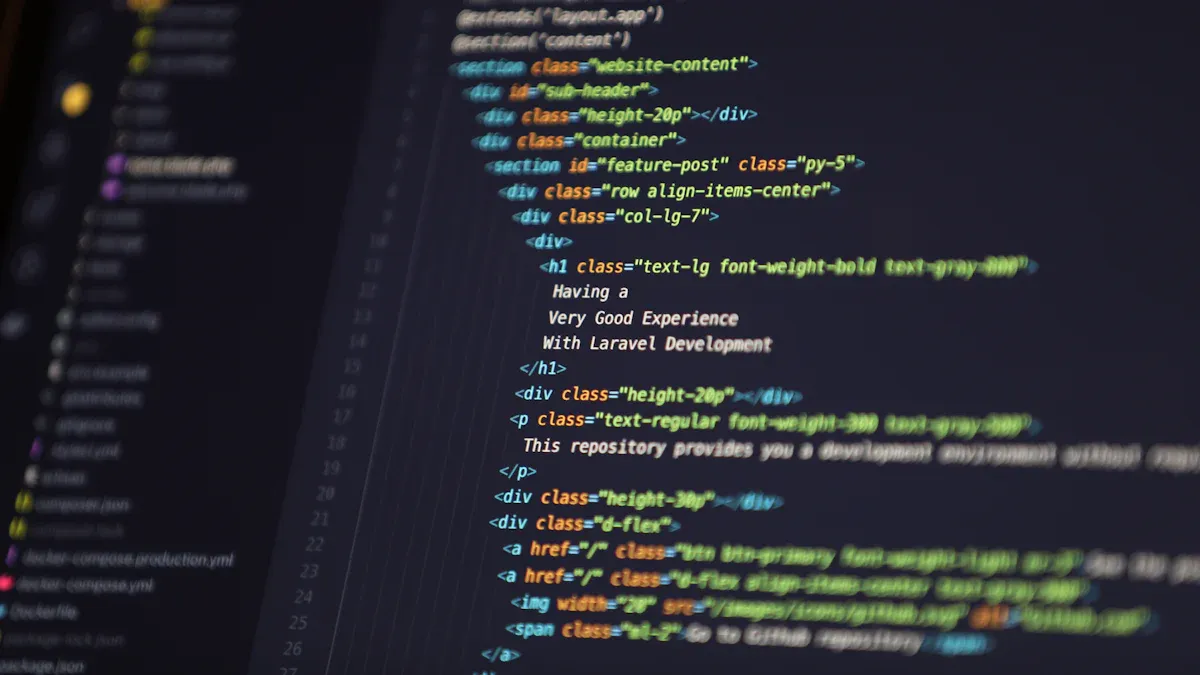Understanding Buffer in Circuit for Better Electronics
A buffer in circuit plays a crucial role in electronics. It acts as a mediator between components, ensuring they stay connected seamlessly without any issues. Think of it as a safeguard that prevents one part from overloading or interfering with another. By maintaining signal stability, the buffer in circuit ensures signals are transmitted clearly and without degradation, even in complex systems.
Tip: Incorporating a buffer in circuit can enhance performance and increase the longevity of the system.
Buffers in circuit are highly beneficial in applications like audio systems, microcontrollers, and power configurations. They strengthen circuits and enable them to handle various tasks efficiently.
Key Takeaways
Buffers work like helpers in circuits, keeping signals clear and steady.
Adding a buffer improves how electronics work and last longer.
Buffer circuits separate signals, shielding delicate parts from problems.
There are different buffers, like voltage and current ones, for special jobs.
Using buffers in microcontrollers makes data faster and more reliable.
Buffer amplifiers are key in audio and video, keeping signals strong and clear.
Picking the right buffer makes circuit building easier and better.
Testing buffers often finds and fixes signal problems early.
What is a Buffer in Circuit?

Definition of a Buffer Circuit
A buffer in circuit helps make signals stronger and steadier. It works like a bridge, helping parts of a system connect without problems. Think of it as a shield that stops one part from messing up another. Buffers are very important for keeping signals clear, especially when many parts work together.
Here are some official definitions of buffer circuits:
Standard | Description |
|---|---|
MULTIMEDIACARD (MMC) ELECTRICAL STANDARD | Gives design rules and tools for buffer circuits in memory. |
ADDENDUM No. 3A to JESD8 - GUNNING TRANSCEIVER LOGIC | Explains input and output rules for fast digital circuits. |
FBDIMM STANDARD: DDR2 SDRAM FULLY BUFFERED DIMM | Lists rules for memory modules using buffer circuits. |
These standards show how buffers are used in memory and fast systems.
How Buffer Circuits Work in Electronics
A buffer amplifier takes a signal and passes it along unchanged. It keeps the input and output separate, so one part doesn’t affect the other. For example, a voltage buffer keeps the same voltage but provides enough current for the load.
Buffers stop loading effects, which happen when too much current is pulled, ruining the signal. By acting as a middleman, the buffer protects the source and keeps the signal strong. This makes moving signals between circuit parts easier.
Importance of Buffer Circuits in Signal Processing
Buffer circuits are key to better signal processing. They stop loading effects that can ruin signals. Buffers help signals stay clear and steady as they move through the circuit. For example, in voltage dividers, buffers allow higher resistance, saving power while working well.
Buffer amplifiers also make weak signals stronger and more stable. This is very useful in audio and video systems, where small errors can lower quality. Buffers also help circuits handle fast data without mistakes, making them vital in today’s electronics.
Note: Adding a buffer in circuit improves performance and helps systems last longer.
Key Functions of Buffer Circuits
Signal Isolation and Protection
Buffer circuits help keep signals separate and safe. They act like walls between parts, stopping electrical problems and protecting delicate circuits. For example, in medical machines like ECGs, buffers stop shocks and keep readings correct. In factories, buffers clean up signals from sensors, keeping them clear in noisy places. High-voltage power checks also use buffers to measure safely, protecting tools and people.
Buffers stop parts with different electrical setups from causing problems. This keeps signals steady and reduces noise, making buffers very important for accurate and reliable systems.
Impedance Matching in Circuits
Buffers are great for fixing impedance mismatches. When parts don’t match, signals can weaken or bounce back. Buffers fix this by matching the source and load impedance. This helps signals move smoothly and stay clear.
In sound systems, buffers stop sound distortion, keeping the audio clear. In radio circuits, they help signals flow without loss. Buffers are also key in data systems, where clear signals are needed for good measurements.
Signal Amplification and Stabilization
Buffers make weak signals stronger and steadier. They boost signals without changing how they work. This is helpful in sound systems, sensors, and voltage controls, where steady signals are needed.
Buffers stop signals from getting messed up by keeping their strength and shape. They also keep signals stable by separating parts, so outside factors don’t ruin them. Buffers save energy by matching impedance, helping power move efficiently.
Buffers also stabilize signals in filters and radio circuits, where accuracy is critical. By keeping signals strong and clear, buffers ensure systems work well in many uses.
Tip: Use buffer amplifiers to protect and strengthen signals in sensitive circuits.
Types of Buffer Circuits
Buffer circuits have different types for specific electronic tasks. Knowing these types helps you pick the best one.
Voltage Buffer Amplifier
A voltage buffer amplifier keeps the signal's voltage steady. It also provides enough current to power the load. This ensures the input signal stays unchanged by the load. These buffers are used in audio systems, sensors, and other areas needing clear signals.
Voltage buffers are grouped by their parts. For example, JFET and BJT amplifiers work differently. The table below shows their differences:
Metric | JFET Buffer Amplifiers | BJT Buffer Amplifiers |
|---|---|---|
Input Resistance | High | Lower |
Input Bias Current | Low | Higher |
Offset Voltage | Worse | Better |
Thermal Distortion | Present | Less noticeable |
These amplifiers are great for circuits needing high resistance and low current. Using a voltage buffer amplifier keeps your circuit working well without signal problems.
Current Buffer Amplifier
A current buffer amplifier moves current between circuits smoothly. It takes low-impedance output and powers high-impedance input. This keeps the system stable. These buffers are important in power systems and motor controls.
Current buffers have special features like zero input impedance and infinite output impedance. These make them efficient and reliable. They also separate circuits, stopping unwanted effects. Adding a current buffer amplifier protects circuits from overload and keeps them steady.
Digital Buffer Circuits
Digital buffer circuits are made for digital systems. They strengthen weak signals, keeping them clear as they move. These buffers are used in microcontrollers, communication tools, and computers.
Digital buffers stop signals from getting worse in fast data systems. They also fix timing issues by syncing signals in circuits. Using digital buffers improves how well digital systems work.
Tip: Picking the right buffer type helps your circuit work better and last longer.
Practical Applications of Buffer Circuits

Buffer Circuits in Microcontroller Systems
Buffer circuits are important for microcontroller systems. They make them faster and work better. Buffers speed up memory access, helping data move quickly to the CPU. This is very useful in real-time tasks where speed matters a lot. For example, when microcontrollers handle hard tasks like loops, buffers keep them fast and accurate. Buffers also save code history, making tasks run smoothly. Adding buffers can improve how well your microcontroller projects work.
Tip: Use a buffer in real-time systems to make them faster and more reliable.
Role of Buffer Amplifiers in Audio and Video Systems
Buffer amplifiers help keep audio and video signals clear. They stop the output from being affected by the load. This improves current flow and reduces wasted power. These features are great for home theaters or professional audio setups. The table below shows how buffer amplifiers help:
Benefit | Description |
|---|---|
Current Delivery | Improves current flow by separating the output from the load. |
Power Dissipation | Saves power by reducing the main op-amp's current load. |
Stability | Keeps performance steady, even with long cables or tough loads. |
Signal Conditioning | Speeds up signal processing, keeping audio and video quality high. |
Isolation Impedance | Reduces cable effects, making the system work better. |
Buffer amplifiers ensure clear and steady signals in audio and video systems, even in tough conditions.
Application of Buffer Circuits in Power Management
In power management, buffers help systems work well and stay reliable. They send strong clock signals to parts, lowering timing mistakes and improving reliability. For microprocessors, buffers send clock signals to different parts for smooth operation. Buffer amplifiers also have high input impedance and low output impedance. This helps signals move easily between different circuits. Buffers stop signals from getting messed up by acting as a bridge.
Note: Buffers in power management protect circuits from overload and make them more efficient.
Buffers also separate input and output circuits. This lets parts work alone without causing problems. This keeps the system working well, even in hard situations.
Advantages of Using Buffer Circuits
Keeping Signals Strong with Buffer Amplifiers
Buffer amplifiers help signals stay clear and strong in circuits. They stop signals from getting weaker or distorted as they move through different parts. Buffers separate the input and output, so changes in the load don’t affect the source signal. This is very helpful in fast systems where small errors can cause big problems.
Buffers keep the signal’s size and shape the same.
They stop signals from losing quality over long distances.
High input impedance and low output impedance allow smooth signal flow.
For example, in sound systems, buffers keep the audio clear even with many devices connected. In fast data systems, buffers stop mistakes caused by weak or distorted signals.
Tip: Add a buffer amplifier to protect signals and improve their quality in tricky circuits.
Making Circuits Work Better and Last Longer
Buffers make circuits more reliable and work better. They act like shields, protecting sensitive parts from electrical noise or changes in the load. Buffers keep each part working on its own, lowering the chance of big problems in the system.
Buffers improve stability by separating input and output.
They keep circuits working well, even with changing loads.
High input impedance stops too much current from being pulled, while low output impedance helps power move easily.
In factories, buffers clean up signals from sensors in noisy places. In medical machines, buffers make sure signals are correct and safe for patients.
Note: Using buffers can help your electronics last longer by protecting important parts from damage.
Easier Circuit Design with Voltage and Current Buffers
Buffers make designing circuits simpler by fixing common problems like mismatched parts or weak signals. Voltage buffers keep the voltage steady and provide enough current for the load. Current buffers help current move smoothly between parts with different setups.
Voltage buffers have high input impedance and low output impedance, making them great for connecting different parts.
Current buffers move current without messing up the signal.
Both types of buffers reduce the need for extra parts, making designs easier.
For example, in power systems, voltage buffers keep control signals steady when handling big loads. In sound amplifiers, current buffers stop distortion, keeping the sound clear and steady.
Tip: Pick the right buffer type to make your circuit easier to design and work better.
Common Challenges and Solutions in Using Buffer Circuits
Fixing Signal Distortion
Signal distortion can harm how circuits work. It happens when signals lose their shape or strength while moving through parts. To stop this, use methods that clean and steady signals. One helpful way is the cascaded all-optical buffer. This method uses a special effect in a semiconductor optical amplifier. It fixes pulse distortion and cuts down on noise. The table below shows its benefits:
Method | Description | Results |
|---|---|---|
Cascaded all-optical buffer | Uses nonlinear polarization rotation in a gain-transparent semiconductor optical amplifier | Fixes pulse distortion, reduces noise, and stores data packets for six round-trips (33 μs delay) |
Using these methods keeps signals clear and circuits reliable.
Tip: Test circuits often to catch and fix distortion early.
Reducing Power Use in Buffer Amplifiers
Buffer amplifiers can use a lot of power, especially in strong systems. Lowering power use helps save energy and reduce heat. Choose amplifiers with low quiescent current and set them up well. Use energy-saving designs and parts to cut power loss. Turning off the amplifier when not needed also saves energy.
Match the amplifier's specs to the circuit's needs. This avoids wasting power and keeps performance good. These steps make your system more efficient.
Note: Saving power helps devices last longer and work better.
Making Buffer Circuits Compatible
Buffer circuits must work well with other parts. When replacing old parts, keep the new ones compatible. New parts should work like the old ones to avoid problems. This lets you use current systems without big changes.
For example, when adding a new buffer, check its voltage and current match the connected parts. This stops signal issues and protects the circuit. By focusing on compatibility, you build systems that are reliable and flexible.
Tip: Always check new parts' specs before adding them to your circuit.
Buffer circuits are important in electronics. They help signals move smoothly and protect parts from damage. Buffers work as helpers, keeping signals clear and stopping parts from interfering with each other.
Key Points:
Functions: Buffers keep signals separate, fix impedance issues, and steady circuits.
Types: Voltage, current, and digital buffers are used for different tasks.
Applications: Buffers improve how microcontrollers, audio systems, and other devices work.
Remember: Adding buffer circuits makes devices work better and last longer. They are key to building strong and reliable electronics today.
FAQ
What does a buffer circuit do?
A buffer circuit keeps signals clear and stops interference. It makes weak signals stronger and steadier for smooth movement in the circuit.
How is a buffer amplifier different from a regular amplifier?
A buffer amplifier boosts signals without changing them. Regular amplifiers increase signal size, but buffers focus on keeping signals stable and clear.
Can buffer circuits save energy?
Yes, buffer circuits save energy by matching impedance and cutting power waste. They help signals move smoothly, using less energy in electronic systems.
Where are digital buffer circuits used?
Digital buffer circuits are found in microcontrollers, communication tools, and computers. They keep signals clear and timed in fast digital systems.
Why is impedance matching important?
Impedance matching stops signal loss and bouncing back. It helps signals move smoothly, making circuits work better and more reliably.
Do audio systems need buffer circuits?
Yes, audio systems need buffer circuits. They keep sound clear, stop distortion, and work well even with long wires or changing loads.
How do buffer circuits protect delicate parts?
Buffer circuits shield delicate parts from high currents or voltages. They act as guards, stopping damage and keeping the system safe.
What should you check when picking a buffer circuit?
Check the signal type (analog or digital), impedance needs, and use case. Picking the right buffer ensures your circuit works its best.
Tip: Test your buffer circuit in real setups to check it works well.
See Also
Fundamentals of Digital Circuit Counters Explained Clearly
Exploring The Roles of Circuit Board Components in Electronics
A Comprehensive Guide to 1N4007 Diode Applications
